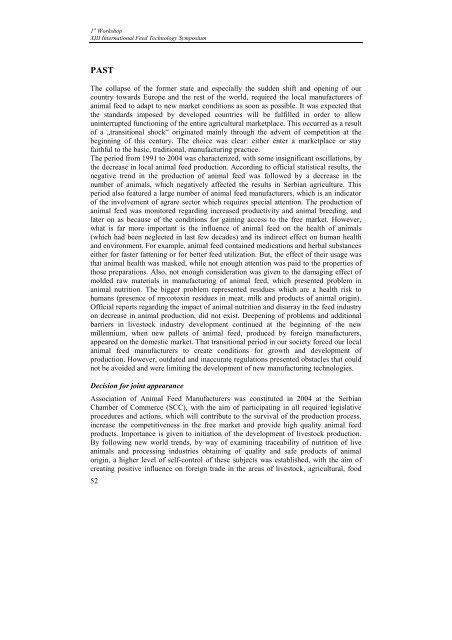Effects of dietary n-3 polyunsaturated fatty acids and ... - FINS
Effects of dietary n-3 polyunsaturated fatty acids and ... - FINS
Effects of dietary n-3 polyunsaturated fatty acids and ... - FINS
Create successful ePaper yourself
Turn your PDF publications into a flip-book with our unique Google optimized e-Paper software.
1 st WorkshopXIII International Feed Technology SymposiumPASTThe collapse <strong>of</strong> the former state <strong>and</strong> especially the sudden shift <strong>and</strong> opening <strong>of</strong> ourcountry towards Europe <strong>and</strong> the rest <strong>of</strong> the world, required the local manufacturers <strong>of</strong>animal feed to adapt to new market conditions as soon as possible. It was expected thatthe st<strong>and</strong>ards imposed by developed countries will be fulfilled in order to allowuninterrupted functioning <strong>of</strong> the entire agricultural marketplace. This occurred as a result<strong>of</strong> a „transitional shock“ originated mainly through the advent <strong>of</strong> competition at thebeginning <strong>of</strong> this century. The choice was clear: either enter a marketplace or stayfaithful to the basic, traditional, manufacturing practice.The period from 1991 to 2004 was characterized, with some insignificant oscillations, bythe decrease in local animal feed production. According to <strong>of</strong>ficial statistical results, thenegative trend in the production <strong>of</strong> animal feed was followed by a decrease in thenumber <strong>of</strong> animals, which negatively affected the results in Serbian agriculture. Thisperiod also featured a large number <strong>of</strong> animal feed manufacturers, which is an indicator<strong>of</strong> the involvement <strong>of</strong> agrare sector which requires special attention. The production <strong>of</strong>animal feed was monitored regarding increased productivity <strong>and</strong> animal breeding, <strong>and</strong>later on as because <strong>of</strong> the conditions for gaining access to the free market. However,what is far more important is the influence <strong>of</strong> animal feed on the health <strong>of</strong> animals(which had been neglected in last few decades) <strong>and</strong> its indirect effect on human health<strong>and</strong> environment. For example, animal feed contained medications <strong>and</strong> herbal substanceseither for faster fattening or for better feed utilization. But, the effect <strong>of</strong> their usage wasthat animal health was masked, while not enough attention was paid to the properties <strong>of</strong>those preparations. Also, not enough consideration was given to the damaging effect <strong>of</strong>molded raw materials in manufacturing <strong>of</strong> animal feed, which presented problem inanimal nutrition. The bigger problem represented residues which are a health risk tohumans (presence <strong>of</strong> mycotoxin residues in meat, milk <strong>and</strong> products <strong>of</strong> animal origin).Official reports regarding the impact <strong>of</strong> animal nutrition <strong>and</strong> disarray in the feed industryon decrease in animal production, did not exist. Deepening <strong>of</strong> problems <strong>and</strong> additionalbarriers in livestock industry development continued at the beginning <strong>of</strong> the newmillennium, when new pallets <strong>of</strong> animal feed, produced by foreign manufacturers,appeared on the domestic market. That transitional period in our society forced our localanimal feed manufacturers to create conditions for growth <strong>and</strong> development <strong>of</strong>production. However, outdated <strong>and</strong> inaccurate regulations presented obstacles that couldnot be avoided <strong>and</strong> were limiting the development <strong>of</strong> new manufacturing technologies.Decision for joint appearanceAssociation <strong>of</strong> Animal Feed Manufacturers was constituted in 2004 at the SerbianChamber <strong>of</strong> Commerce (SCC), with the aim <strong>of</strong> participating in all required legislativeprocedures <strong>and</strong> actions, which will contribute to the survival <strong>of</strong> the production process,increase the competitiveness in the free market <strong>and</strong> provide high quality animal feedproducts. Importance is given to initiation <strong>of</strong> the development <strong>of</strong> livestock production.By following new world trends, by way <strong>of</strong> examining traceability <strong>of</strong> nutrition <strong>of</strong> liveanimals <strong>and</strong> processing industries obtaining <strong>of</strong> quality <strong>and</strong> safe products <strong>of</strong> animalorigin, a higher level <strong>of</strong> self-control <strong>of</strong> these subjects was established, with the aim <strong>of</strong>creating positive influence on foreign trade in the areas <strong>of</strong> livestock, agricultural, food52
















